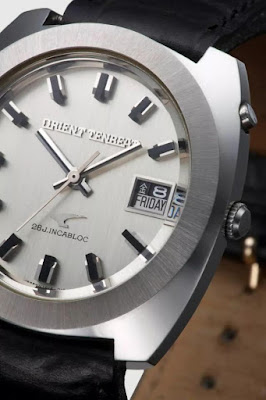If the
story of the rarest Orient of all has whetted your appetite for obscure,
legendary unicorns from Orient's past, today we have another one for you. Today
we'll talk about the Orient Tenbeat, a watch that we've actually touched on
briefly in this old post concerning the Orient GM.
First,
a little watchmaking history. The race for movements with faster frequencies
heated up in the mid 1960's, as both Swiss and Japanese manufacturers were
aiming for the 5 Hz, or 10 beats per second, goal. The benefit, presumably,
would have been higher accuracy than the then-prevailing 2.5 or 3 Hz calibers;
the cost, most likely, greater wear of the mechanical components.
While
Girard Perregaux were first to hit the target in 1966, Seiko did not take much
longer to come up with their own competitor, cal. 5740c, which in 1967 was
placed inside the brand's Lord Marvel watch (which, by the way, I have as well –
it's super smooth to this day).
Of
course, other Japanese brands could not afford to stay behind. Citizen
presented its caliber 7230-driven Leopard 36000 in 1969, and soon after, in
1970, Orient presented a 5 Hz movement of its own – the 28 Jewel,
incabloc-equipped, cal. 9980.
Orient
seems to have taken much pride in that caliber, mentioning it in many lists of
historical achievements advertised by the brand. While there is very little
"behind the scenes" information from that era in Orient, the movement
does not seem to bear much visual resemblance to Seiko's 5740 or to Citizen's
7230, so it was likely all or mostly engineered in-house. If that is true, it
is evidence of Orient's technical prowess.
The
watch itself appears to have been quite nice, featuring a cushion case, a
simple yet attractive dial, and the day and date presented one on top of the
other in one large window. Both day and date had a quickset option, one
from the crown and the other using the pusher at 2.
Like
in the case of the "rarest orient" WE0011DU, there are hardly any
real-life photos of the Tenbeat available. The only ones I could find were posted
years ago by this museum
shop in Japan.
Once
again, this watch is beyond rare. Its footprint is so faint it almost does not
exist at all. And yet, surely, some Tenbeats must exist, somewhere! So if you
ever come across one – keep quiet, try not to scare it; take a picture of it,
mark the place where you saw it, and move away carefully. Oh, and share all the
details with me!




From the pic , it shares a similar train bridge (a finger between the balance cock and the bridge) with the Chronoaces 429 cal.
ReplyDeleteInteresting observation. Makes sense as they were being developed roundabout the same time, to be using common designs - particularly in non-moving parts.
DeleteI own a Chronoace that seems to have that same case. Do you have any references for that model? I haven’t bothered restoring it as I assumed it was missing a bezel. I’m trying to find as much info regarding that case as possible.
ReplyDeleteAs a matter of fact, the dial is identical as well. It’s a 429 powered watch.
ReplyDeleteFrom available sources, it appears the 9980 combined 42970 base caliber with additional elements, some taken from the 399 (the Fineness movement) and some some adaptations to the higher beat rate.
DeleteThe Tenbeat that finished at auction last night fetched a very strong price - over Y300k. I wonder if this might bring a few others out of the woodwork.
ReplyDeleteLet's hope so! I remember when I got a "red alpinist" Seiko a few years ago, it was the first anyone had seen in a long while - afterwards, they started showing up in numbers. Anyway it's encouraging to even know these watches are out there and not just hiding in some Orient Museum...
DeleteI hope so too. I’ve had two similar experiences, both with rarely-seen variants of a Citizen Leopard Super Beat 10. After seeing (and acquiring) the first ones on offer for years, a couple of others popped up very soon after. Someone is always watching!
ReplyDelete